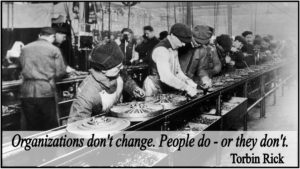The Challenge of Change Management

People don’t like change. Just try switching your watch from one wrist to the other. How many times will you look at the wrong wrist during your day? How many sighs of exasperation will you suffer before you decide that this change isn’t working, give up, and move your watch back to “where it belongs”? Even when change is relatively minor, it can be both disruptive and annoying.
This is one of the core reasons businesses struggle with change management—people don’t like change. There are many change management theories out there that address this issue, but most of them tend to focus more on project management and the technical side of change. Change management isn’t a subset of project management, it’s an essential complementary piece.
On its own, change management is a more flexible approach that focuses on the people involved. The goal of change management is to get the people who will be implementing the changes to accept, adopt, embrace and employ the changes over the long term. Some people try to “sell” their employees on the changes, but even this approach requires an employee’s understanding and buy-in. If an employee doesn’t understand why the changes need to happen, or how the changes are going to affect them personally, in both the short and long term, they’re less likely to be an active and willing participant. Ultimately, they might even become disruptive and decide to “put the watch back where it belongs.”
An anecdotal story illustrates the differing attitudes and behaviors of people on an assembly line. An interviewer asked one employee on the line what he did. He explained that he checked small parts for defects, admitting that it was tedious and boring and that he quite possibly missed one now and then, but figured it would get caught further down the line. The interviewer walked down the line and asked another employee what her job was. She proudly pointed out the window at a newly completed space shuttle. “I help build those!” she exclaimed. Two extraordinarily different perspectives.
Your vision may be the cornerstone of changes in your business, but many of the people who will be actively turning your vision into a reality know things about their corner of your business that you don’t. Who knows your customers better than your front-line people? If a change will affect a user, isn’t it a good strategy to run the options by the user? They may pick up on a small but critical element the theorists missed. How will you access their knowledge if you don’t provide them with an opportunity to share it? What reason will they have to invest in your vision if they don’t see a place for themselves and what they bring to the table within it?
Successfully implementing changes that can withstand the test of time is not the result of a one-time event. Change is a process. No one would ever expect someone to play their cello at Carnegie Hall after one lesson. Nor should employees be expected to embrace and master skills with one training session. People need time, knowledge, training, coaching and feedback to acquire new habits.
Developing resourceful change and project management initiatives that complement each other is vital to your business’s future success. The choice of which changes are necessary for your vision to become a reality is always going to be yours to make. Your success, on the other hand, is dependent on all the people who are going to be helping you implement those changes.